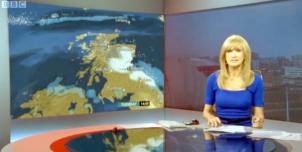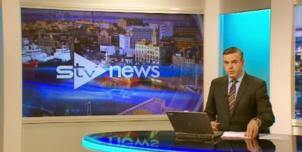Full Freeview on the Durris (Aberdeenshire, Scotland) transmitter
| Google Streetview | Google map | Bing map | Google Earth | 57.000,-2.392 or 56°59'59"N 2°23'30"W | AB39 3TH |
The symbol shows the location of the Durris (Aberdeenshire, Scotland) transmitter which serves 180,000 homes. The bright green areas shown where the signal from this transmitter is strong, dark green areas are poorer signals. Those parts shown in yellow may have interference on the same frequency from other masts.
This transmitter has no current reported problems
The BBC and Digital UK report there are no faults or engineering work on the Durris (Aberdeenshire, Scotland) transmitter._______
Digital television services are broadcast on a multiplexes (or Mux) where many stations occupy a single broadcast frequency, as shown below.
64QAM 8K 3/4 27.1Mb/s DVB-T MPEG2
H/V: aerial position (horizontal or vertical)
Which Freeview channels does the Durris transmitter broadcast?
If you have any kind of Freeview fault, follow this Freeview reset procedure first.Digital television services are broadcast on a multiplexes (or Mux) where many stations occupy a single broadcast frequency, as shown below.
64QAM 8K 3/4 27.1Mb/s DVB-T MPEG2
H/V: aerial position (horizontal or vertical)
Which BBC and ITV regional news can I watch from the Durris transmitter?

BBC Reporting Scotland 2.4m homes 9.2%
from Glasgow G51 1DA, 173km southwest (224°)
to BBC Scotland region - 230 masts.

STV News 0.4m homes 1.5%
from Aberdeen AB12 3QH, 23km northeast (52°)
to STV North (Aberdeen) region - 76 masts.
Are there any self-help relays?
| Aberdeen (old Town) | Transposer | 2 km N city centre | 837 homes (dealer estimate) |
| Aberdeen-talisman | Transposer | 1 km SW city centre | 100 homes |
| Fyvie | Active deflector | 37 km NW Aberdeen | 10 homes Hotel |
| Glen Tanar | Active deflector | 11 km E Ballater | 13 homes |
| Glenlivet | Transposer | 15 km E Grantown-on- Spey | 70 homes School |
| Haughton House C/p | Transposer | 1 km N Aford Aberdeenshire | 1 homes 150 caravans |
| Oyne | Active deflector | 33 km NW Aberdeen | 11 homes |
| Strathdon A | Transposer | 60 km W Aberdeen | 25 homes |
| Strathdon B | Transposer | 25 homes | |
| Strathdon C | Transposer | ‘appreciable population' | |
| Strathdon D | Active deflector | ||
| Strathdon E | Active deflector | ||
| Strathdon F | Active deflector |
How will the Durris (Aberdeenshire, Scotland) transmission frequencies change over time?
| 1961-80s | 1984-97 | 1997-98 | 1998-2010 | 2010-13 | 3 Oct 2018 | ||||
| VHF | A K T | W | W | A K T | W T | ||||
| C9 | ITVwaves | ||||||||
| C22 | BBC1waves | BBC1waves | BBC1waves | BBCB | BBCB | ||||
| C23 | SDN | SDN | |||||||
| C25 | ITVwaves | ITVwaves | ITVwaves | D3+4 | D3+4 | ||||
| C26 | ArqA | ArqA | |||||||
| C28 | BBC2waves | BBC2waves | BBC2waves | BBCA | BBCA | ||||
| C29 | ArqB | ||||||||
| C30 | _local | ArqB | |||||||
| C32 | C4waves | C4waves | C4waves | com7 | |||||
| C35 | com8 | ||||||||
| C41 | _local | ||||||||
| C55tv_off | com7tv_off | ||||||||
| C56tv_off | COM8tv_off | ||||||||
| C67 | C5waves | C5waves |
tv_off Being removed from Freeview (for 5G use) after November 2020 / June 2022 - more
Table shows multiplexes names see this article;
green background for transmission frequencies
Notes: + and - denote 166kHz offset; aerial group are shown as A B C/D E K W T
waves denotes analogue; digital switchover was 1 Sep 10 and 15 Sep 10.
How do the old analogue and currrent digital signal levels compare?
| Analogue 1-4 | 500kW | |
| Analogue 5, BBCA, D3+4, BBCB | (-7dB) 100kW | |
| SDN, ARQA, ARQB | (-10dB) 50kW | |
| Mux 1*, Mux 2*, Mux A* | (-14dB) 20kW | |
| com7, com8 | (-15.4dB) 14.5kW | |
| Mux B* | (-17dB) 10kW | |
| Mux C*, Mux D* | (-20dB) 5kW |
Local transmitter maps
Durris Freeview Durris TV region BBC Scotland STV North (Aberdeen micro region)Which companies have run the Channel 3 services in the Durris transmitter area
|
|
Is the transmitter output the same in all directions?
Radiation patterns withheldMonday, 20 June 2011
A
Alan7:33 AM
Since 15th June I have also lost most of my channels. We live in Huntly and can now only get the two multiplexes delivering the BBC and ITV channels. When is this going to be sorted out?
| link to this comment |
K
KMJ,Derby8:11 AM
Alan: The COM muxes changed frequency and increased power on 15th June 2011. Do a factory reset to clear the channel list then rescan for channels.
| link to this comment |
K
KMJ,Derby8:27 AM
Alan: Further to the above post It is likely that a channel clash is occurring with the PSB channels from Knock More. What is your postcode so a check can be made for reception from Knock More?
| link to this comment |
A
Alan8:49 AM
Huntly
KMJ,
I have previously cleared the channels by doing a scan with the ariel disconnected but it didn't help. My post code is AB54 8FA.
| link to this comment |
Alan's: mapA's Freeview map terrainA's terrain plot wavesA's frequency data A's Freeview Detailed Coverage
J
Joe Wheeler11:14 AM
I also rescanned, but the problem seems to have gone since I made my post yesterday, I can now get dave, etc again.
| link to this comment |
A
Alan12:58 PM
Huntly
Problem solved but it meant switching to the Knock More transmitter. Rather annoying as the Durris "upgrade" is costing me money. At least I have a solution whereas the engineer told me that some people affected simply cannot get a signal from Knock More so satellite might be the only solution.
| link to this comment |
Alan's: mapA's Freeview map terrainA's terrain plot wavesA's frequency data A's Freeview Detailed Coverage
M
Mike Dimmick1:12 PM
Alan: The problem for you is that the final COM channels from Durris clash with the PSB channels from Knock More. (The underlying cause is probably the governments' decision to release channels 31 to 40, and 60 to 68, meaning less space for digital TV transmissions.)
Knock More is closer to you - 23km vs 55km - but Durris is more powerful, 100kW vs 20kW. Distance has more effect than the transmitter's power - theoretical calculations show that you should receive slightly higher signal levels from Knock More than from Durris. It does also depend on the terrain - there are hills blocking line of sight to both transmitters, but I would say the situation with Durris is worse than Knock More.
| link to this comment |
M
Mike Dimmick1:16 PM
Will: If you already have a wideband aerial, you don't need to change it. However, you're right that a Group A aerial should provide more gain, for a given size of aerial.
There's a chance that any new interleaved services could start up outside Group A. The report produced for Ofcom's review on the subject constrained the channel selections to those within or just outside the traditional analogue group, including Channel 5. You needed a wideband aerial for analogue C5, so they could have selected any channel between 21 and 60, though in fact the channel producing the best coverage from Durris was C30.
| link to this comment |
K
KMJ,Derby1:52 PM
Albert Alexander and Andrew Marjoram: The problem in Aberchirder is the frequency clash betwean the COM muxes from Durris and the PSB muxes from Knock More. I tried a postcode in Aberchirder which suggested that the best solution is to diplex a group A aerial for PSB muxes from Durris to a group C/D aerial on Knock more for the Com muxes. The situation could of course be different for different locations around Aberchirder.
| link to this comment |
Tuesday, 21 June 2011
B
bear12:27 PM
Have done a manual and auto re-tune, you might find QVC,5usa,5*,etc have moved up the channel list into the 800's
| link to this comment |
Select more comments
Your comment please!




